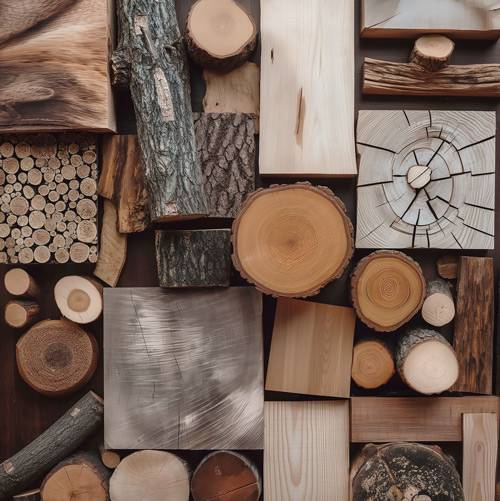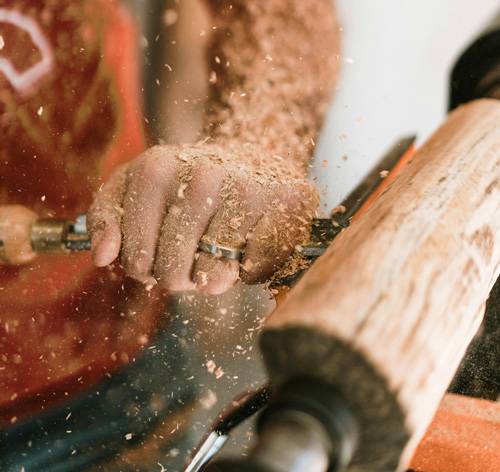What is wood
Wood is a renewable raw material and is one of the most widely used plant products in the world.
It is also one of the most stable substances in the plant kingdom and enables trees to reach heights of over 50 meters.
Wood consists of tubular cellulose cells that are glued together by a solid, colorless hydrocarbon compound called lignin. The lignin is stored in the cell wall and serves as a strengthening element, which is why the lignification of plant cells is also known as lignification.
The size and structure of the cells varies depending on the tree species and determines the properties of the wood such as weight, density and strength. Botanically speaking, there are hardwoods (angiosperms) and softwoods (gymnosperms), whereby hardwoods are generally heavier and harder than softwoods.

Types of wood
The classification of wood into softwood and hardwood is based on the botanical distinction between softwoods and hardwoods. However, this classification does not necessarily reflect the actual hardness of the wood.
Softwood
Softwood usually comes from conifers, which do not lose their leaves in winter and usually have needles instead of leaves. The most common types of softwood include:
- Spruce
- Pine
- Fir
Softwoods are often used for furniture, construction timber and paper production, as they grow faster and are therefore cheaper.
Hardwood
Hardwood typically comes from deciduous trees that lose their leaves in the fall. These woods are regularly harder and denser than softwoods, making them ideal for the manufacture of durable furniture, flooring and other high-quality products. Examples of hardwood species are:
- Oak
- beech
- Maple
There are also hardwoods that originate from tropical regions (tropical woods). These can be very hard and resistant to weathering, which makes them popular for outdoor use. Examples of this are:
- teak
- mahogany
- Ebony
It is important to note that the use of some tropical woods can be controversial due to deforestation and environmental concerns. Sustainability certificates such as FSC (Forest Stewardship Council) can help ensure that wood products come from responsibly managed forests.

Wood applications
Wood is a versatile natural material that has been used in various areas for thousands of years. It is not only sustainable, but also aesthetically pleasing and offers a warm appearance. Here are some of the main uses of wood:
Wood processing
Woodworking includes techniques and methods for processing wood into useful and decorative objects. This includes sawing, planing, milling, sanding and joining wooden parts. In woodworking, both manual skills and mechanical processes are used to produce furniture, sculptures, toys and other wooden products.
Timber construction
In timber construction, wood is used as the primary building material for structures such as houses, bridges and even high-rise buildings. Thanks to modern technologies such as cross-laminated timber (CLT), large and complex structures can now be built efficiently and sustainably from timber. Timber construction is particularly popular in regions with abundant timber resources and is seen as an environmentally friendly alternative to traditional building materials such as concrete and steel.

Wooden furniture
Wooden furniture is highly valued for its durability, natural beauty and versatility. From rustic kitchen tables to modern bookshelves, wood can be used in a variety of styles. It combines well with other materials and can be adapted to different interior designs through various surface treatments such as staining, varnishing or oiling.
These applications only show a fraction of the possibilities that wood offers as a material. Its sustainability, workability and aesthetic quality make it an excellent choice for many projects in industry and trade.

Sustainability of wood
Wood is a sustainable raw material that can be an environmentally friendly alternative to fossil or non-renewable materials. The sustainability of wood depends on various factors, such as sustainable forest management, processing and use of the wood.
Sustainable forestry includes certifications, reforestation and the preservation of biodiversity as well as the reduction of interventions. During processing, attention should be paid to energy efficiency, durability and recycling as well as local production.
Sustainable wood offers advantages such as CO₂ storage, renewability and biodegradability. Challenges include illegal deforestation, climate change and social aspects. It is important to pay attention to certifications and opt for products from sustainable sources.





